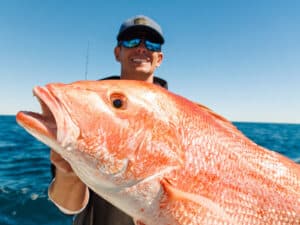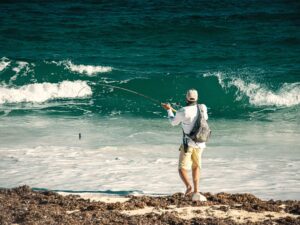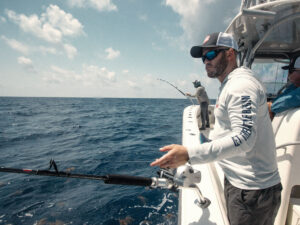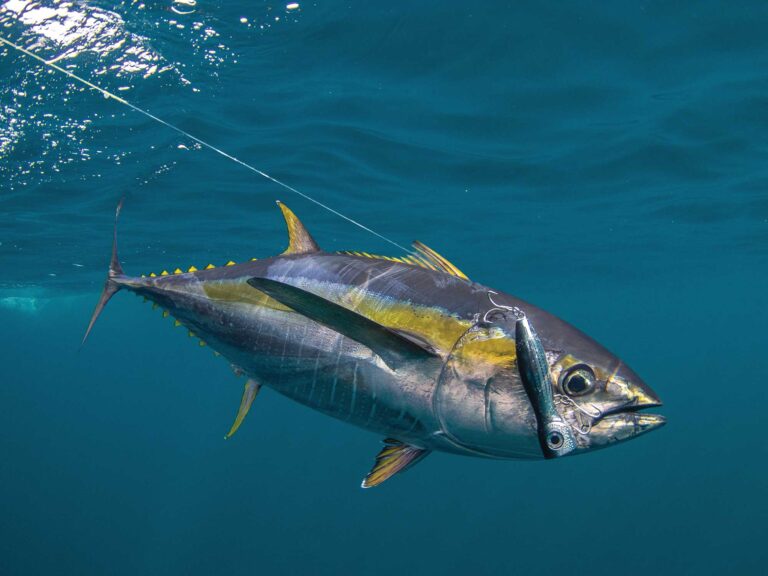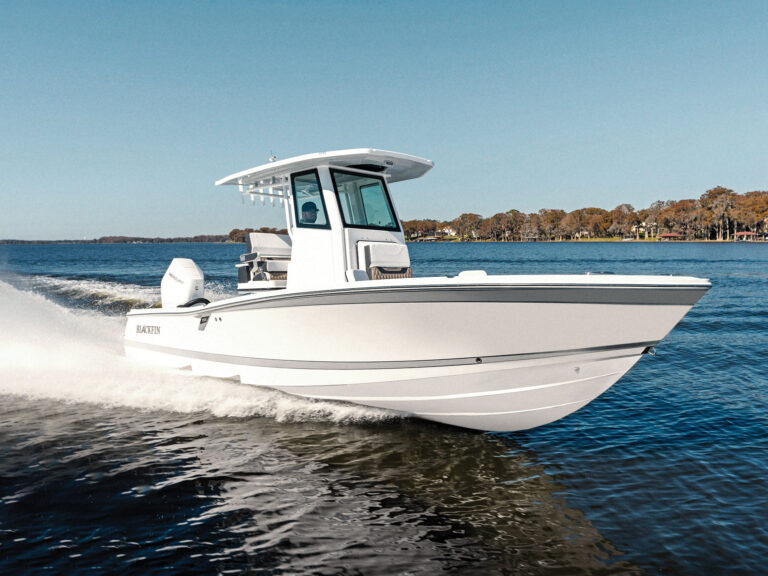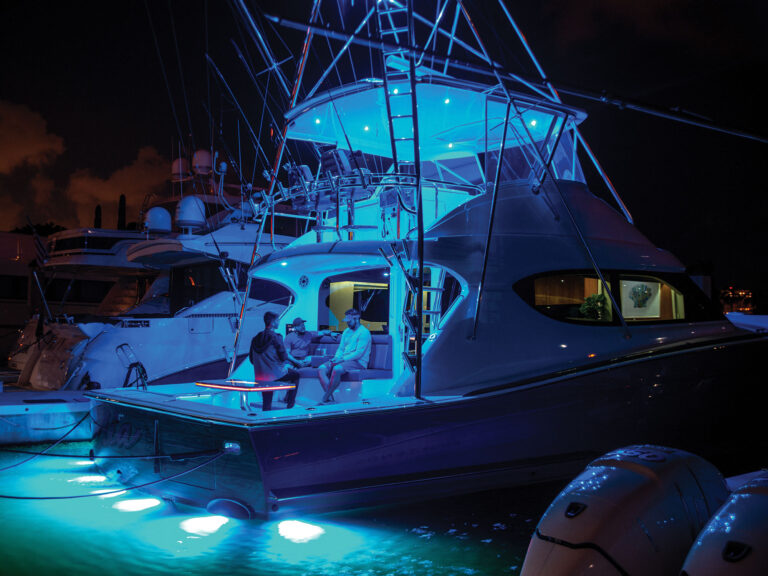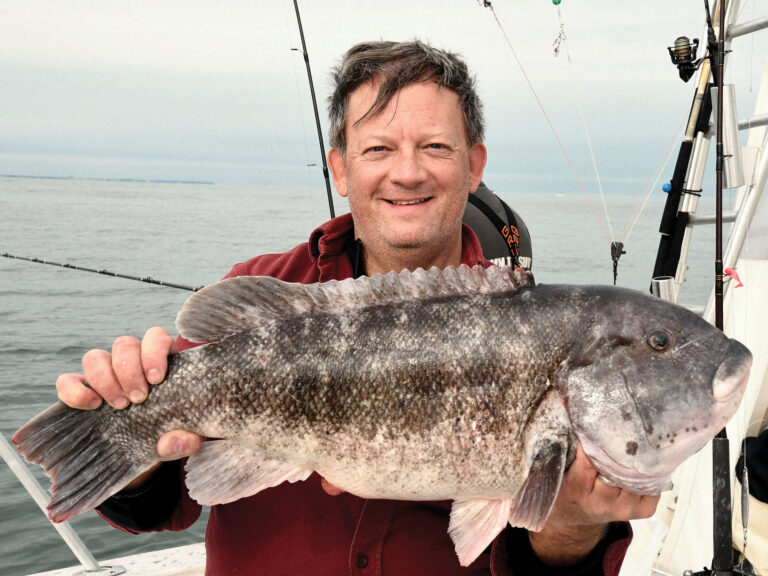Back in the day, before fish coolers became a status symbol, saltwater anglers struggled to keep their catch cold. When I started fishing, coolers were inefficient and flimsy. Back then, coolers were also inexpensive and easy to repair. Broken handles, busted hinges and cracked plastic were just part of the game.
About 20 years ago, cooler manufacturers took a different approach to cold storage. Instead of cheap disposable coolers, anglers can pay a premium for an indestructible and efficient super cooler. Eye- catching design and overbuilt insulation and construction make the new generation of coolers really cool. Now anglers can preserve fish longer with less ice and these tougher-than-nails coolers survive years of abuse to guarantee fish arrive at the cleaning table ready for processing.
Key Considerations for Choosing a Fish Cooler for Small Boats
Size and Space
The biggest challenge to cold storage on a small boat is the available deck space. I use four coolers on my 20-foot Jones Brothers center console: a large cooler for fish, a medium cooler for lunch and a small cooler for bait. For fish that are too big for the cooler, I have a fish bag folded in my bow hatch. I chose the largest coolers that fit in my boat without getting in the way.
In my boat I use a Yeti Tundra 125 for fish, a 35 Tundra for lunch and a Yeti Hopper Flip 18 for my frozen bait. The biggest downside to a super cooler is size and weight. The thicker insulation and heavier plastic reduce capacity in a similar size cooler. When I switched from a 150-quart Igloo Marine cooler to the 125 Yeti Tundra, I gave up 25 quarts of storage space with the same outside dimensions.
However, the more efficient Yeti allows me to carry less ice making up for the sacrificed volume. Despite the reduced capacity, I have never run out of space in the 125-quart fish cooler for a boat limit of sea bass or a 40-pound cobia. When I catch a giant cobia or king mackerel, the Reliable Fishing Products fish bag with a bag of ice keeps the trophy cold.
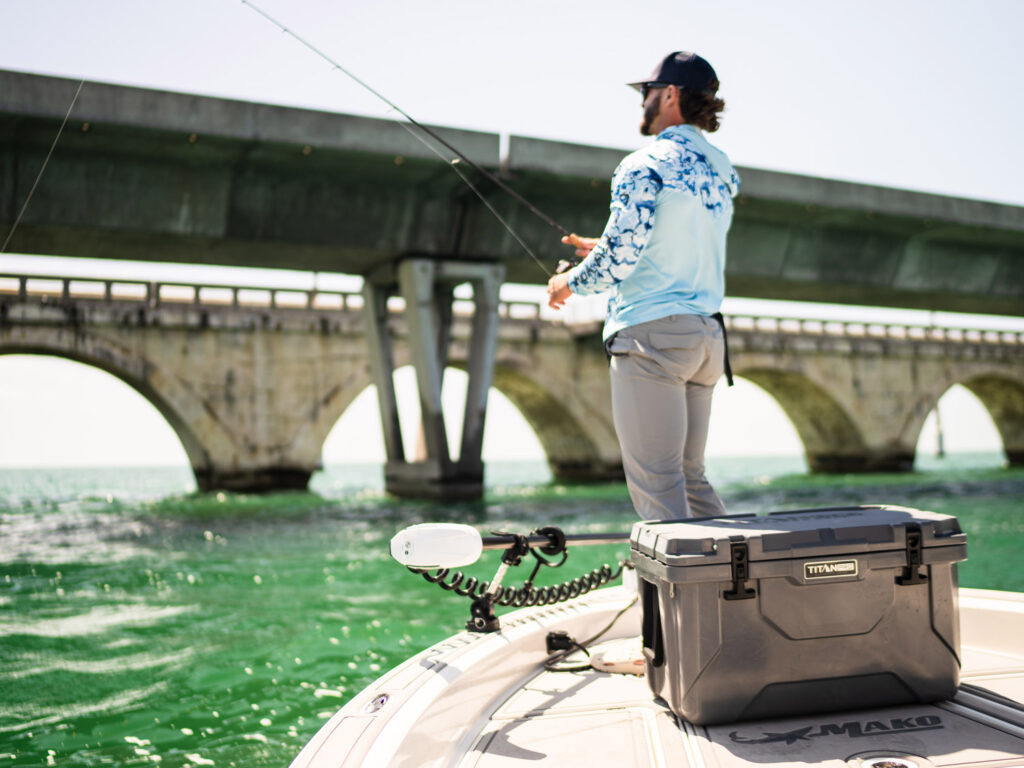
Durability
By the time I finally replaced my old fish box, the hinges were broken, the latches were gone and the handles were permanently twisted. Since I bought a Yeti fish cooler, I haven’t had a single issue.
Instead of cheap plastic hinges, the Yeti has a stainless steel rod running through molded-in hinges that stretch the length of the cooler. Thick rubber latches are embedded in the lid. The roto-molded plastic is the same stuff used in whitewater kayaks and playground equipment.
For the past 10 years, my premium coolers iced down my fish and cold drinks without fail. My coolers live outside and they haven’t faded or cracked. The hinges and latches work perfectly. The plastic is scratched and gouged but it hasn’t failed. After a decade, the coolers work as well as the day I bought them.
Insulation
A cooler’s main objective is keeping contents cold. The amount and quality of insulation improves the cooler’s performance. Premium fish coolers use two inches of highly efficient foam insulation to separate cold air inside from the hot air outside. To further improve cold retention, premium coolers use a rubber gasket around the lid that seals the cooler like a refrigerator. The result is a fish cooler that can maintain ice for days.
Features
A fish cooler for a small boat doesn’t need a lot of extra features. Cup holders, bottle openers and wheels are great for tailgating or a day on the beach, but a fish cooler has one job: keep fish cold.
The most important features are aimed at cold storage, durability and easy ownership. Sturdy hinges, tough latches and high quality plastic are more important than accessories. A smooth surface inside and outside the cooler is easier to clean and maintain. When the seas get rough, a cooler needs non-slip rubber feet and tie-down points to strap the cooler to the boat deck.
Top Picks for Best Fish Coolers for Small Boats
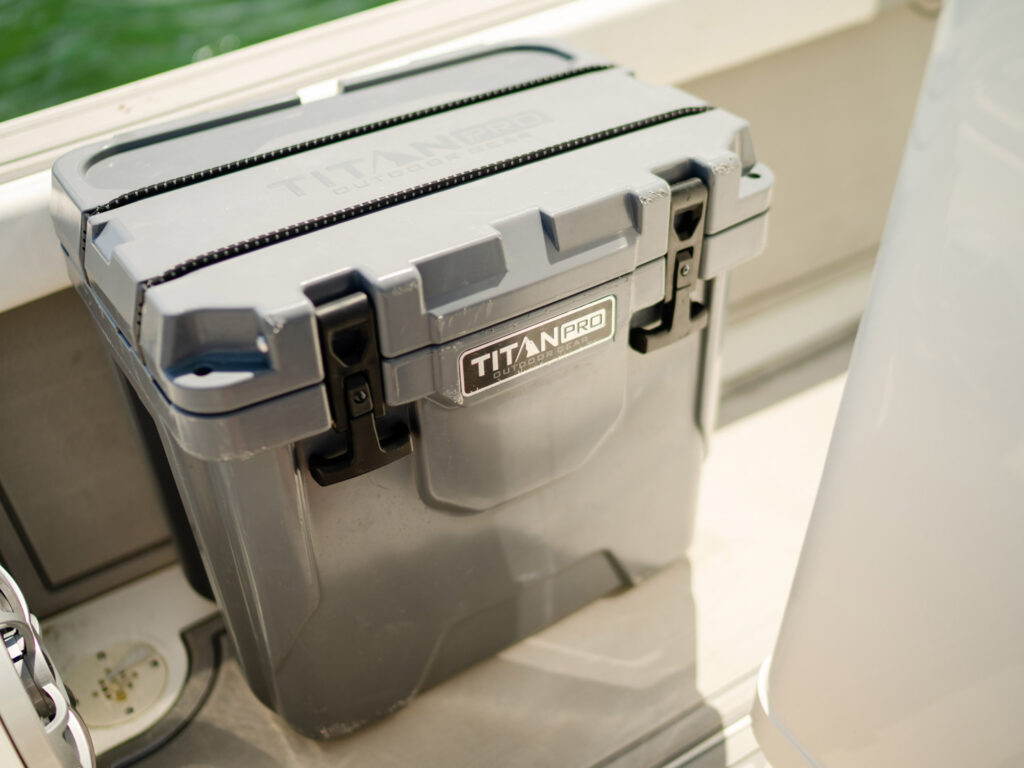
Titan Pro Roto Hard Coolers
Titan PRO has rolled out a new line of rotomolded super-coolers designed for excellent ice retention and durability. They also feature cool innovations you won’t find anywhere else. Titan PRO took a bombproof shell, added heavy duty components, as well as excellent insulation and a freezer-grade gasket that holds ice for days. Then, to cut down on warm-air intrusion, they threw in a thermal inner cover—called Ice Saver—for even better ice retention. Easy to clean and featuring built-in bacterial growth inhibitor, Titan PROs were made for hauling fish as well as cold beer. They even thought of a waterproof, removable LED for fishing in the dark or unloading after an extra-long day.
- Sizes: 25 and 55 quarts
- Weight: 19.1 to 31.9 pounds
- Price: $275 to $400
Pros:
- Extremely durable
- Excellent ice retention
- Long list of additional functional features
Cons:
- Expensive
- Heavy
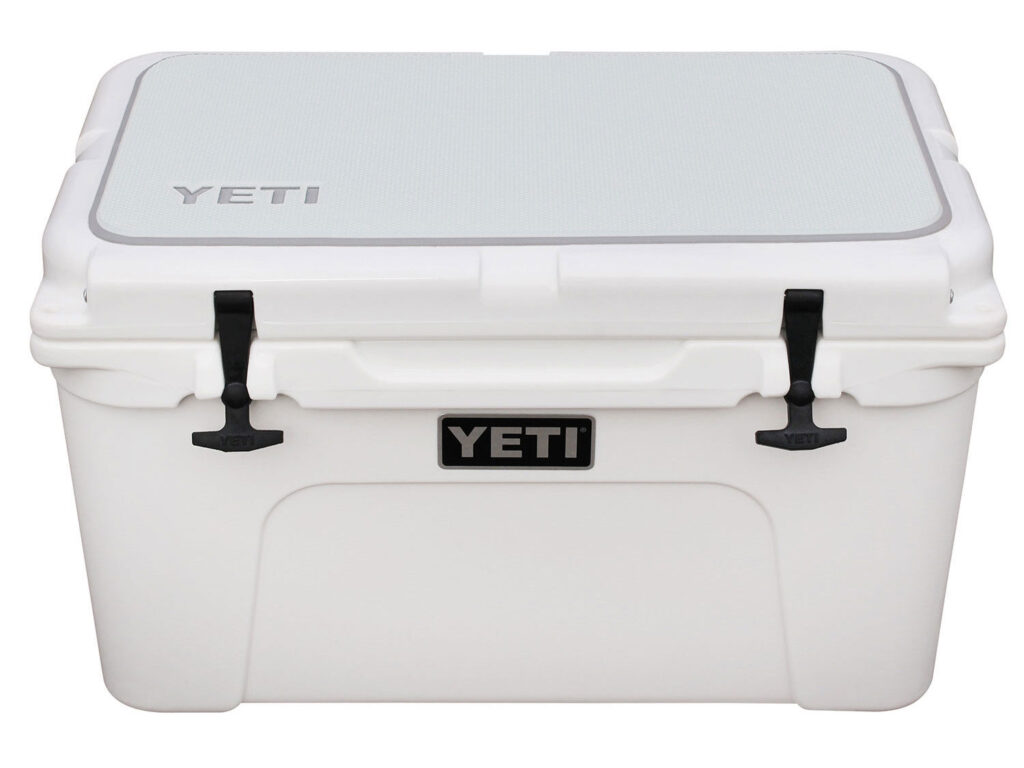
Yeti Tundra
Outdoor enthusiasts wear Yeti hats and decorate their car windows with Yeti stickers to show they are serious about their sport. The original super cooler, the Yeti Tundra has many imitators but no match for durability and efficiency. Rotomolded plastic, molded in hinge with stainless steel pin, rubber latches and rope handles are ready for years of abuse. Two inches of high-quality foam insulates the cooler to keep ice frozen for days. My favorite feature is the Yeti drain plug with small holes to drain water without removing the plug from the cooler. After a decade using Yeti coolers, I can say the super coolers live up to the hype.
- Sizes: 35 to 350 quarts
- Weight: 21.4 to 92.8 pounds
- Price: $275 to $1500
Pros:
- Indestructible hinges and latches
- Two inches of insulation
- Rotomolded construction
Cons:
- Expensive
- Heavy
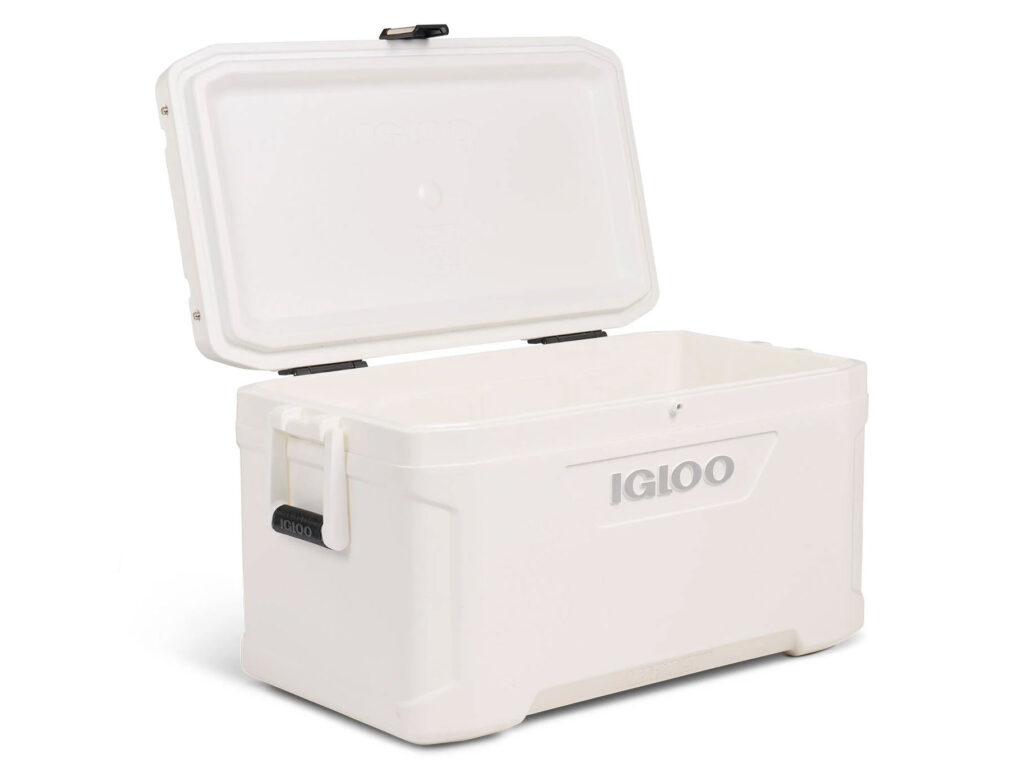
Igloo Marine Elite
Igloo marine coolers have kept fish cold for over 50 years. To compete with the modern super coolers, Igloo improved quality without raising the price. Plastic hinges and latches have been replaced with stainless steel. The hard plastic handles are now slip-resistant and beefed up. At the end of my fishing trip, I connect a garden hose to the threaded drain plug and siphon the meltwater out of my boat without dumping the cooler on the deck. The igloo cooler is significantly lighter than a roto-molded cooler so it is easier to move and carry.
- Sizes: 25 to 100 quart
- Weight: 6.4 to 24.2 pounds
- Price: $44.99 to $99.99
Pros:
- Lightweight
- Stainless steel hardware
- Inexpensive
Cons:
- No rubber seal on the lid
- Latches, handles and hinges are attached to the cooler with screws
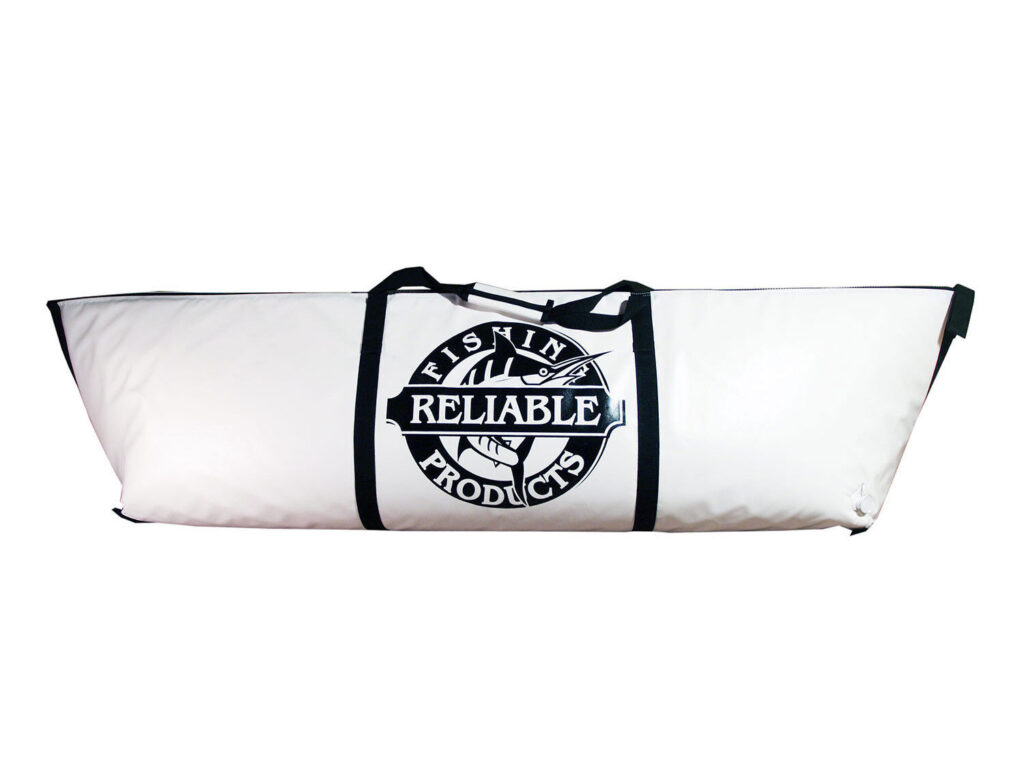
Reliable Marine Fish Bag
To provide extra cold storage on my small boat, I fold a Reliable Marine Fish Bag and stuff it in my anchor locker. The soft-sided fish bag is built like an inflatable river raft with puncture and tear-proof vinyl fabric. An inch of flexible insulation keeps a big fish cold until I reach the cleaning table. The inside of the bag is blue to trap cold air and the outside white to reflect the sun’s rays.
- Size: 50 to 475 quarts
- Price: $225 to $549
Pros:
- Easy to store
- Hand-sewn in the USA
Cons:
- Not as efficient as a hard cooler
- Not completely watertight (it may leak meltwater)
Tips for Using a Fish Cooler on a Small Boat
Maintaining my coolers is an important part of my fishing program. I trailer my boat so I pick up 50 pounds of ice on my way to the boat ramp. I dump a 10-pound bag of cubed ice into my lunch cooler and open the drain plugs. I leave two 20 pound bags of ice intact in my fish cooler. To keep my frozen bait frozen, I pack it in a 18 quart soft cooler stored inside my fish box.
During the day, I keep the fish cooler drain plugs closed to trap cold air and meltwater. As I add fish to the cooler, the bags of ice cool my catch. Keeping the bags intact slows the ice melting and elevates my catch out of the meltwater. As the ice melts, I add kosher salt to the meltwater to create a brine.
Towards the end of the day, once my catch is cooled, I open one of the ice bags and dump it on the fish. Then, I open the drain plugs and release the meltwater. By the time I reach home, the fish are ice cold.
The process is made possible by my fish cooler’s incredible efficiency. The thick insulation and sealed lid allow me to use less ice to keep my catch cold. The system is so efficient, storing my bait cooler inside the fish box keeps my bait frozen all day. If I need more space in the fish box, I remove the bait cooler and the contents stay frozen until I return home.
When I catch a fish too large for the fish box, I pull out my fish bag and add a bag of ice to cool the trophy for the ride to the cleaning table.
After I remove the fish and bait, I tip the cooler on its side and spray out the slime, blood and guts. I clean the cooler with dish soap and a 6:1 mixture of water to bleach. I use a terry cloth rag and a soft bristle hand brush to scrub the inside and outside of the cooler, careful to remove hidden gunk from the cooler rim and rubber gasket. Then, I prop the lid open and set the cooler in the sun to dry.
Find a Cooler That Fits Your Boat
To keep fish cold for a day-long fishing trip, I don’t have to break the bank with an expensive premium fish cooler. For cooling my catch, I can use an inexpensive marine cooler and add more ice. However, investing in a premium cooler with durable construction and thick insulation uses less ice and lasts longer than a less expensive cooler. My advice is to choose the largest fish box that will fit in the boat. Then buy an insulated fish bag for a large fish. With the best cooler for a small boat, my catch is cold and ready for processing so I can provide safe and healthy seafood for my family.

